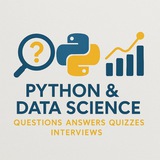❓ Interview question :
What is NumPy, and why is it essential for scientific computing in Python?
❓ Interview question :
How do arrays in NumPy differ from Python lists?
❓ Interview question :
What is the purpose of ndarray in NumPy?
❓ Interview question :
How can you create a 2D array using NumPy?
❓ Interview question :
What does shape represent in a NumPy array?
❓ Interview question :
How do you perform element-wise operations on NumPy arrays?
❓ Interview question :
What is broadcasting in NumPy, and how does it work?
❓ Interview question :
How do you reshape a NumPy array using reshape()?
❓ Interview question :
What is the difference between copy() and view() in NumPy?
❓ Interview question :
How do you concatenate two NumPy arrays along a specific axis?
❓ Interview question :
What is the role of axis parameter in NumPy functions like sum(), mean(), etc.?
❓ Interview question :
How do you find the maximum and minimum values in a NumPy array?
❓ Interview question :
What are ufuncs in NumPy, and give an example?
❓ Interview question :
How do you sort a NumPy array using np.sort()?
❓ Interview question :
What is the use of np.where() in conditional indexing?
❓ Interview question :
How do you generate random numbers using NumPy?
❓ Interview question :
What is the difference between np.random.rand() and np.random.randn()?
❓ Interview question :
How do you load data from a file into a NumPy array?
❓ Interview question :
What is vectorization in NumPy, and why is it important?
❓ Interview question :
How do you calculate the dot product of two arrays in NumPy?
#️⃣ tags: #NumPy #Python #ScientificComputing #Array #ndarray #ElementWiseOperations #Broadcasting #Reshape #CopyView #Concatenation #AxisParameter #MaximumMinimum #ufuncs #Sorting #ConditionalIndexing #RandomNumbers #DataLoading #Vectorization #DotProduct
By: t.iss.one/DataScienceQ 🚀
What is NumPy, and why is it essential for scientific computing in Python?
❓ Interview question :
How do arrays in NumPy differ from Python lists?
❓ Interview question :
What is the purpose of ndarray in NumPy?
❓ Interview question :
How can you create a 2D array using NumPy?
❓ Interview question :
What does shape represent in a NumPy array?
❓ Interview question :
How do you perform element-wise operations on NumPy arrays?
❓ Interview question :
What is broadcasting in NumPy, and how does it work?
❓ Interview question :
How do you reshape a NumPy array using reshape()?
❓ Interview question :
What is the difference between copy() and view() in NumPy?
❓ Interview question :
How do you concatenate two NumPy arrays along a specific axis?
❓ Interview question :
What is the role of axis parameter in NumPy functions like sum(), mean(), etc.?
❓ Interview question :
How do you find the maximum and minimum values in a NumPy array?
❓ Interview question :
What are ufuncs in NumPy, and give an example?
❓ Interview question :
How do you sort a NumPy array using np.sort()?
❓ Interview question :
What is the use of np.where() in conditional indexing?
❓ Interview question :
How do you generate random numbers using NumPy?
❓ Interview question :
What is the difference between np.random.rand() and np.random.randn()?
❓ Interview question :
How do you load data from a file into a NumPy array?
❓ Interview question :
What is vectorization in NumPy, and why is it important?
❓ Interview question :
How do you calculate the dot product of two arrays in NumPy?
#️⃣ tags: #NumPy #Python #ScientificComputing #Array #ndarray #ElementWiseOperations #Broadcasting #Reshape #CopyView #Concatenation #AxisParameter #MaximumMinimum #ufuncs #Sorting #ConditionalIndexing #RandomNumbers #DataLoading #Vectorization #DotProduct
By: t.iss.one/DataScienceQ 🚀
